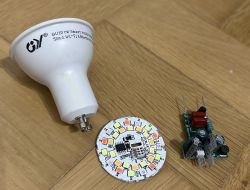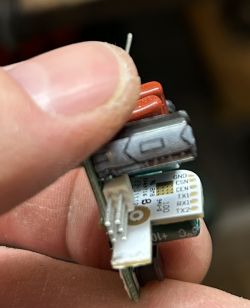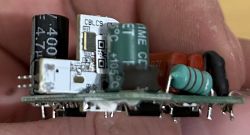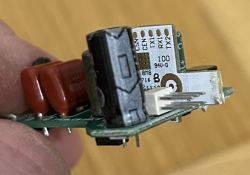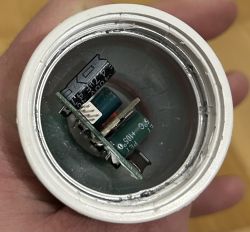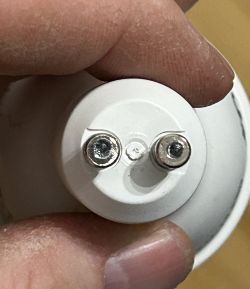This is a short teardown of the GY gu10 which is based on BK7231N and it uses a tuya module CBLC9 and BP5768
Basic Info:
https://www.amazon.fr/GY-GU10-connect%C3%A9e-compatible-2700K-6500K/dp/B09M3677F7
![[BK7231N - CBLC9] Teardown & Flashing GY GU10 RBGWW: Tuya Module, Pin Config & OpenBeken Fir [BK7231N - CBLC9] Teardown & Flashing GY GU10 RBGWW: Tuya Module, Pin Config & OpenBeken Fir](https://obrazki.elektroda.pl/4529764800_1680617716_thumb.jpg)
![[BK7231N - CBLC9] Teardown & Flashing GY GU10 RBGWW: Tuya Module, Pin Config & OpenBeken Fir [BK7231N - CBLC9] Teardown & Flashing GY GU10 RBGWW: Tuya Module, Pin Config & OpenBeken Fir](https://obrazki.elektroda.pl/3249658700_1680617742_thumb.jpg)
Flashing OpenBeken firmware:
Using cloudcutter
Select OpenBK7231N / By Fimware version and name / 1.3.21 BK7231N / Kanlux / 33643 GU10 RGBCCT
after the firmware change, for pin configuration
![[BK7231N - CBLC9] Teardown & Flashing GY GU10 RBGWW: Tuya Module, Pin Config & OpenBeken Fir [BK7231N - CBLC9] Teardown & Flashing GY GU10 RBGWW: Tuya Module, Pin Config & OpenBeken Fir](https://obrazki.elektroda.pl/1748584500_1680610866_thumb.jpg)
P7 = BP5758D_DAT
P26 == BP5758D_CLK
add the start command
![[BK7231N - CBLC9] Teardown & Flashing GY GU10 RBGWW: Tuya Module, Pin Config & OpenBeken Fir [BK7231N - CBLC9] Teardown & Flashing GY GU10 RBGWW: Tuya Module, Pin Config & OpenBeken Fir](https://obrazki.elektroda.pl/2099991500_1680610943_thumb.jpg)
BP5758D_Map 2 1 0 3 4
Enjoy
Basic Info:
https://www.amazon.fr/GY-GU10-connect%C3%A9e-compatible-2700K-6500K/dp/B09M3677F7
![[BK7231N - CBLC9] Teardown & Flashing GY GU10 RBGWW: Tuya Module, Pin Config & OpenBeken Fir [BK7231N - CBLC9] Teardown & Flashing GY GU10 RBGWW: Tuya Module, Pin Config & OpenBeken Fir](https://obrazki.elektroda.pl/4529764800_1680617716_thumb.jpg)
![[BK7231N - CBLC9] Teardown & Flashing GY GU10 RBGWW: Tuya Module, Pin Config & OpenBeken Fir [BK7231N - CBLC9] Teardown & Flashing GY GU10 RBGWW: Tuya Module, Pin Config & OpenBeken Fir](https://obrazki.elektroda.pl/3249658700_1680617742_thumb.jpg)
Flashing OpenBeken firmware:
Using cloudcutter
Select OpenBK7231N / By Fimware version and name / 1.3.21 BK7231N / Kanlux / 33643 GU10 RGBCCT
after the firmware change, for pin configuration
![[BK7231N - CBLC9] Teardown & Flashing GY GU10 RBGWW: Tuya Module, Pin Config & OpenBeken Fir [BK7231N - CBLC9] Teardown & Flashing GY GU10 RBGWW: Tuya Module, Pin Config & OpenBeken Fir](https://obrazki.elektroda.pl/1748584500_1680610866_thumb.jpg)
P7 = BP5758D_DAT
P26 == BP5758D_CLK
add the start command
![[BK7231N - CBLC9] Teardown & Flashing GY GU10 RBGWW: Tuya Module, Pin Config & OpenBeken Fir [BK7231N - CBLC9] Teardown & Flashing GY GU10 RBGWW: Tuya Module, Pin Config & OpenBeken Fir](https://obrazki.elektroda.pl/2099991500_1680610943_thumb.jpg)
BP5758D_Map 2 1 0 3 4
Enjoy
Cool? Ranking DIY





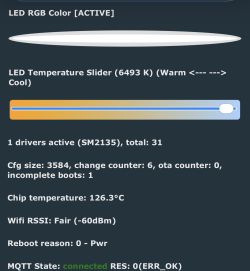

![[BK7231N - CBLC9] Teardown & Flashing GY GU10 RBGWW: Tuya Module, Pin Config & OpenBeken Fir [BK7231N - CBLC9] Teardown & Flashing GY GU10 RBGWW: Tuya Module, Pin Config & OpenBeken Fir](https://obrazki.elektroda.pl/3233401100_1680610624_thumb.jpg)
![[BK7231N - CBLC9] Teardown & Flashing GY GU10 RBGWW: Tuya Module, Pin Config & OpenBeken Fir [BK7231N - CBLC9] Teardown & Flashing GY GU10 RBGWW: Tuya Module, Pin Config & OpenBeken Fir](https://obrazki.elektroda.pl/8454971200_1680617826_thumb.jpg)
